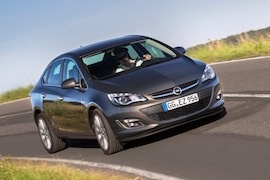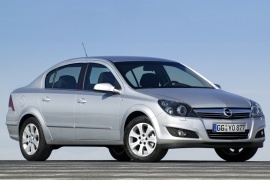
OPEL Astra Sedan
Generations Timeline, Specs and Pictures

The Opel Astra Sedan was launched at the 2012 Moscow International Automobile Salon.
Its siblings with three or five doors were already on the market since 2009.
While the compact-class was dominated by hatchback vehicles, Opel saw a big interest in the sedan-segment in the East European market. After a good experience with the Opel Astra Sedan H, it introduced the three-box version in the Russian market and, later on, that year, it extended it into other markets where that kind of bodyworks was attractive for customers.
The Astra J, or the fourth generation of the compact Opel, the sedan was similar to the 5-door hatchback up to the B-pillar. The roofline descended behind the rear seats to the trunk lid. The rear taillights featured the same design language with the headlights and were different than those installed on the 5-door version.
Inside, while the front seats and dashboard were the same with the 2009 Astra lineup, the rear seats were different and offered slightly more room for the rear passengers. The trunk was opened from the keyfob or via a dedicated button on the trunk.
The Astra Sedan featured different engines, depending on the market. It was sold under the name Buick Excelle GT in China or Buick Verano on the North American Continent.

Unveiled during Istanbul’s Motor Show of 2006, the new Opel Astra sedan was quick to continue the automaker’s long-ago started winning-car streak.
Specifically engineered for east-European markets, the 2007 facelift combines affordability and style with great fuel efficiency and power output. The new model shares the hatchback’s long wheelbase (106.4 in) for increased passenger comfort while providing a spacious trunk volume of 17.6 cubic feet (500 Liters). Upgraded equipment levels include a quick engine-heating system, dual xenon headlights and a Hill Start Assist (HSA) system.

Known also as the Astra G, the second generation of the compact-sedan from Opel was introduced in 1998.
It was a big step ahead of its predecessor, the Astra F.
Most of the complaints regarding the previous model were resolved when the second generation of the Astra was introduced in 1998. It was improved in all the areas. It was offered with a new range of engines and better interior materials. The only part which didn’t evolve was the rear trailing-arm suspension. The sedan version was designed to get e bigger piece of the company car market.
The exterior look featured bigger headlights, a modern grille, and an aerodynamic look. With the radiator grille integrated into the aerodynamically profiled hood, the Astra G offered a dynamic image. Unfortunately, the car was fitted with black handles for the doors, regardless of the color of the car. It was a detail that was changed by the other competitors on the market. The sedan version featured the same doors as the 5-door hatchback. It looked like the trunk was added after the whole project was done and it was built on a budget. But there was a big improvement in assembly quality when compared with its predecessor.
The interior looked like the Opel designers were too busy designing the exterior and left the cabin for the last minute. The fits and finishes were well and the materials used were good, but the general look was bland. There was enough room for five adults but limited for three in the back.
The Astra was offered with a choice of diesel and gasoline engines ranged from 75 hp to 147 hp. Most of them were mated to a 5-speed manual, but a 4-speed automatic was available for selected versions.

Opel introduced a facelifted version for the Astra’s first generation in 1994, after three years on the market, and improved its safety features.
When the German carmaker retired the Kadett nameplate from its lineup, some customers criticized it. But the Astra was a completely new path. While the Kadett built its reputation on sporty versions, the Astra was meant to be a family car and the king of the rental companies. The sedan version was a choice for those who didn’t need a big trunk in the back. Also, the newly opened Eastern European market was hungry for sedans, and the three-box Astra was one of the best offers.
The facelifted version received a new front fascia with a redesigned grille that sported a reversed trapezoidal shape and the chromed Opel badge in the middle. Previously, the Astra featured a one-slat grille. The carmaker dropped the orange lenses for the turn signals favoring the clear-lens system, with orange bulbs inside to comply with the European legislation. Its trunk lid kept the same shape at the back, and the taillights received clear reversing lights instead of the smoked ones from the 1991 model.
Inside, the carmaker introduced a new dashboard, which included a passenger airbag. For the sound system, Opel offered an option for a CD player for the top trim levels, while the base version remained without any radio.
Under the hood, the carmaker introduced a new, 2.0-liter engine for selected markets. They became Euro 2 compliant.

Opel introduced a sedan version for the Astra’s first generation in 1992, a year after the hatchback version, and it wasn’t the best-selling member of the family.
Replacing the Kadett was not an easy decision for the German brand, but it had to be done. The older name didn’t fit the initial market segment. Unlike its predecessor, the Astra didn’t aim at young customers anymore. The carmaker built it mainly for families and empty-nesters. Thus, the sedan version was a good choice, especially for those who needed a car mainly for the front seats and occasionally took some passengers in the back.
The Astra featured a short front fascia with narrow headlights and grille, crossed by a thin slat. From its sides, the design team kept the straight line theme for the rear wheel-arch from the Kadett but enlarged, which started from the rear doors. A rear glass area covered the space between the back doors and the C-pillars, while the short and flat trunk lid sat out of the driver’s sight.
Inside, Opel placed its bets on a simple, functional interior centered around the driver. For that, it installed a tilted center stack, with easy-to-reach climate control buttons on the lower side and the stereo cassette above it. In the instrument panel, the carmaker placed the speedometer in the middle, flanked on the sides by the tachometer and a common area for the fuel and coolant temperature gauges. Opel designed new seats for the Astra, with no bolstering on the sides. The sedan version provided adequate room for the rear occupants as well, especially if they were children.
Under the hood, Opel installed seven gasoline and two oil burners. The diesel versions were supplied by Isuzu and were offered with or without a turbocharger.























































